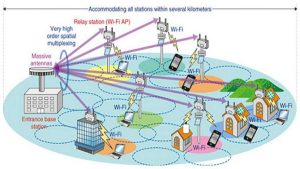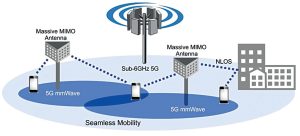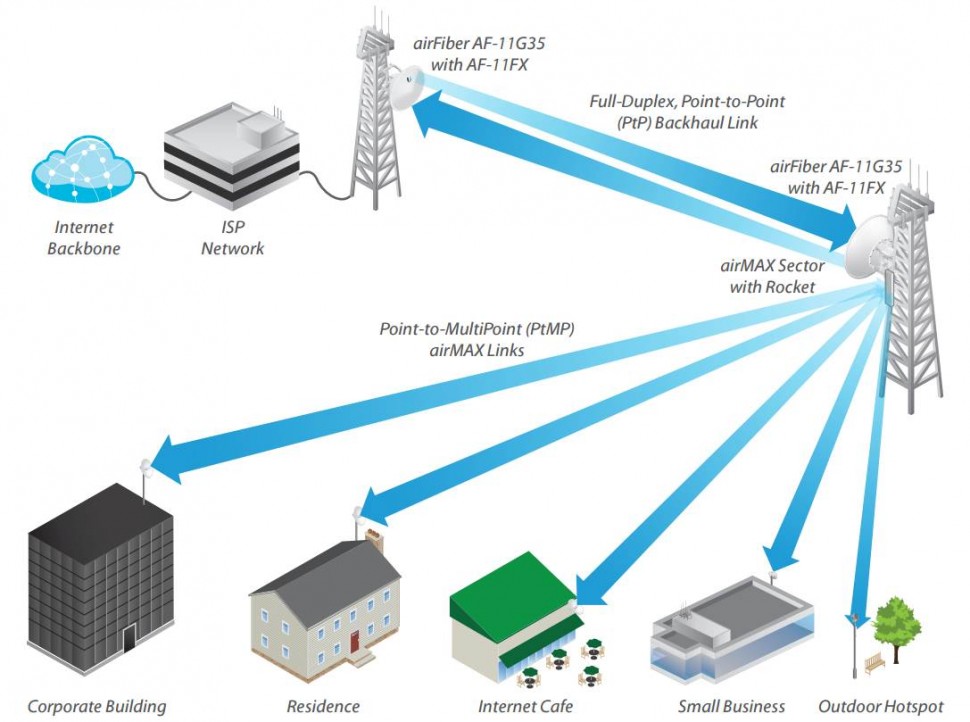The utilization of spatial multiplexing in MIMO wireless communication is a fundamental technique that baffles many due to its ability to transmit multiple data streams simultaneously, all within the same frequency band. This technique capitalizes on the diversity of antennas by transmitting distinct data streams through various antennas, thereby elevating a MIMO system’s capacity. Spatial multiplexing also serves as an excellent tool for enhancing signal quality and minimizing interference.
To leverage spatial multiplexing in a MIMO system, it necessitates having numerous antennas at both transmitter and receiver ends. The quantity of these antennas dictates the maximum number of self-governing data streams probable to be transmitted concurrently. Mathematical models are employed to estimate channel capacity in MIMO systems with several antennas while considering factors such as path loss, co-channel interference, and multipart propagation.

Signal processing techniques come into play when estimating channel capacity and improving data throughput in MIMO systems equipped with spatial multiplexing. These techniques comprise beamforming – which directs signals towards specific locations; precoding – optimizing signal transmission based on statistical properties of the channel; modulation schemes that adapt rapidly changing conditions real-time. By amalgamating these methods with spatial multiplexing and antenna diversity, it becomes plausible to achieve high-capacity wireless communication even under challenging circumstances like fading or interference!
Exploiting Antenna Diversity and Spatial Multiplexing to Increase Capacity in MIMO Systems
Contents
- 1 Exploiting Antenna Diversity and Spatial Multiplexing to Increase Capacity in MIMO Systems
- 2 Mathematical Models for Channel Capacity in MIMO Systems with Multiple Antennas
- 3 Signal Processing Techniques to Estimate Channel Capacity and Improve Data Throughput in MIMO Systems
- 4 The Fundamental Characteristics of MIMO Wireless Systems and the Role of Spatial Multiplexing
- 5 Increasing Capacity in MIMO Systems by Increasing the Number of Transmit and Receive Antennas
- 6 Theoretical Limits of Channel Capacity in MIMO Systems with Different Spatial and Diversity Schemes
- 7 The Impact of Multipath Propagation, Path Loss, and Co-Channel Interference on the Capacity of Spatial Multiplexed Signals in MIMO Systems
The realm of MIMO wireless communication systems is rife with techniques that can elevate capacity to unprecedented heights. Among these are antenna diversity and spatial multiplexing, each offering unique advantages for signal quality improvement in the face of fading and propagation loss.

Spatial multiplexing enables the transmission of multiple data streams through multiple antennas at both ends, while antenna diversity involves using several antennas on either end. These methods combined can revolutionize a system’s capacity beyond what traditional single-antenna systems could ever achieve.
However, there is one crucial factor that must be taken into account when implementing these strategies: channel estimation. Obtaining accurate estimates of path loss, delay spread and coherence time is vital in optimizing performance. And if you want to take things even further than that, beamforming and space-time coding are signal processing techniques well worth exploring.
By utilizing advanced technology such as this alongside carefully designed transmit/receive antenna configurations, it becomes possible to improve overall system reliability by reducing noise and interference under challenging propagation conditions. The potential gains from exploiting antenna diversity and spatial multiplexing should not be underestimated – they provide an effective way to propel MIMO wireless communication systems beyond their current limitations.
Mathematical Models for Channel Capacity in MIMO Systems with Multiple Antennas
The perplexing and bursty world of wireless communication is dominated by the enigmatic multiple-input and multiple-output (MIMO) systems. These obscure technologies employ a multitude of antennas at both the transmitter and receiver to enhance transmission quality. The MIMO system’s capacity is contingent upon several factors, such as diversity and spatial multiplexing schemes that enable simultaneous data stream transmission, thereby increasing data rates.
Various mathematical techniques are employed to model the channel capacity of MIMO systems. Transmit diversity schemes send distinct versions of identical signals over different paths while augmenting the number of receive antennas captures more information from each transmitted signal – all in an attempt to boost channel capacity beyond its limits.
Spatial multiplexing also plays a crucial role in MIMO systems by facilitating independent data stream transmission over different spatial channels simultaneously. However, path loss and co-channel interference may disrupt spatially multiplexed signals as they traverse diverse pathways before reaching their ultimate destination.
In summary, understanding channel capacity in MIMO systems with numerous antennas requires robust mathematical models that account for transmit diversity, receive antenna count, and spatial multiplexing strategies. Researchers can then leverage these insights into developing effective approaches for enhancing transmission rates while preserving high-quality signals amidst challenging conditions like path loss or interference from nearby frequencies or channels.
Signal Processing Techniques to Estimate Channel Capacity and Improve Data Throughput in MIMO Systems
Signal processing techniques are a perplexing web of methods that burst with complexity, yet they serve an indispensable role in estimating the channel capacity and enhancing data throughput in MIMO systems. One such bewildering technique is spatial diversity, where multiple copies of the same signal traverse through different paths to exploit fading variations and intensify signal reception at the receiver end. The intricacy amplifies as this technique requires an array of multiple antennas at both ends of communication.
Another method that adds to this labyrinthine network is multiplexing, which enables simultaneous transmission of various signals over a single channel by exploiting diverse spatial dimensions. Within this enigmatic universe lies spatial multiplexing, which utilizes distinct antenna elements to transmit independent information streams concurrently. The number of streams transmitted hinges on factors like signal-to-noise ratio (SNR), modulation scheme used, and different spatial diversities involved.
To gauge channel capacity correctly, it’s imperative to construct mathematical models for MIMO systems with numerous antennas and diverse spatial diversity schemes like SISO (Single Input Single Output), SIMO (Single Input Multiple Outputs), MISO (Multiple Inputs Single Output) or MIMO (Multiple Inputs Multiple Outputs). These models provide insight into how much data can be communicated wirelessly under specific conditions like path loss or co-channel interference while optimizing system performance. In summation, Signal processing techniques are crucial for achieving high-throughput rates in LTE-based wireless networks by capitalizing on antenna diversity and spatial multiplexing while accounting for various propagation effects – making them both puzzlingly complex yet remarkably valuable tools in modern technology.
The Fundamental Characteristics of MIMO Wireless Systems and the Role of Spatial Multiplexing
The perplexing and bursty nature of MIMO wireless systems lies in their utilization of multiple antennas at both the transmitter and receiver ends. This spatial multiplexing technique enables several data streams to be transmitted concurrently over the same frequency band, thereby augmenting channel capacity. By harnessing antenna diversity alongside spatial multiplexing, MIMO systems outperform traditional single-antenna setups, delivering higher throughput rates.
To enhance data throughput in MIMO systems, signal processing techniques are deployed to estimate channel capacity. These methods entail scrutinizing signals received by each antenna while applying mathematical models for channel capacity in MIMO systems with multiple antennas. The number of transmit antennas is a critical factor that impacts system performance since it determines how many independent data streams can be sent simultaneously.
Despite theoretical limits on channel capacity due to interference from other channels or co-channel interference across different spatial and diversity schemes in MIMO systems, careful selection of transmission parameters such as modulation scheme and coding rate could mitigate these effects, leading to an overall system boost. In conclusion, comprehending fundamental characteristics such as using spatial multiplexing, employing signal processing techniques for estimating channel capacity alongside optimal selection of transmission parameters all play a crucial role in enabling higher throughput rates through improved data transmission capabilities within MIMO wireless systems.
Increasing Capacity in MIMO Systems by Increasing the Number of Transmit and Receive Antennas
The art of enhancing capacity in MIMO systems has been a hot topic, and one that has led many to explore the potential gains from increasing the number of transmit and receive antennas. The basic principle here is simple: by adding more antennas, it becomes possible to simultaneously send multiple streams of data over the same radio channel. This effectively multiplies available bandwidth, resulting in higher data rates without requiring any additional spectrum or power.
But how can we estimate just how much gain we might achieve from increasing antenna numbers? Well, mathematical models are often employed for this purpose. These models take into account various factors such as signal-to-noise ratio (SNR), independent fading between different antenna pairs and correlations between received signals at each antenna. By considering all these parameters together, it becomes possible to determine precisely how many bits per second can be reliably transmitted over a given frequency band using a particular antenna system.
Of course, there are some challenges associated with boosting capacity through increased use of transmit and receive antennas. One major consideration is the potential issue of co-channel interference when multiple transmitters operate too close together. But never fear! Advanced signal processing techniques exist that can help separate desired signals from unwanted interference – such as beamforming algorithms or sophisticated equalization filters designed specifically to remove distortions caused by multipath propagation effects.
Ultimately then, careful optimization of both hardware and software components is key if we hope to achieve significant gains in throughput and spectral efficiency through increased use of transmit and receive antennas in MIMO systems… but what an exciting challenge it represents!
Theoretical Limits of Channel Capacity in MIMO Systems with Different Spatial and Diversity Schemes
MIMO systems possess a remarkable ability to amplify channel capacity by capitalizing on spatial diversity, which hinges on various factors like the number and layout of antennas at both ends and the presence or nonexistence of co-channel interference. Theoretically speaking, amplifying channel capacity is not a narrow process but rather a broad one that relies on multiple parameters. In general, increasing the number of transmit and receive antennas can lead to higher capacities.
In addition to antenna numbers, another critical aspect in MIMO systems is how simultaneous transmissions from multiple antennas can be leveraged to retrieve independent information streams. This requires sophisticated signal processing techniques that are capable of separating transmitted data based on time and frequency characteristics. Linear methods such as zero forcing or minimum mean square error (MMSE) have been shown to be effective in rich scattering environments with low levels of interference.
To achieve spatial multiplexing in MIMO systems there are three distinct schemes: open loop, closed loop, and hybrid – each with its own strengths and weaknesses depending upon system complexity, feedback requirements, as well as channel conditions. Gaining familiarity with these tradeoffs is crucial for designing efficient MIMO systems that regulate transmission rates while maximizing throughput.
The Impact of Multipath Propagation, Path Loss, and Co-Channel Interference on the Capacity of Spatial Multiplexed Signals in MIMO Systems
The capacity of spatial multiplexed signals in MIMO systems can be significantly impacted by a multitude of factors. Among these are multipath propagation, path loss, and co-channel interference – all posing unique challenges to efficient wireless communication.
Multipath propagation occurs when signals traverse diverse paths to reach the receiver antenna, causing phase shifts and fading that can result in data transmission errors and reduced signal levels. Path loss presents another obstacle as distance between transmitter and receiver antennas increases, leading to decreased signal strength due to attenuation from various obstacles like walls or structures. To combat this issue, different transmit power levels may be employed for each antenna or parallel transmissions with multiple antennas used for better coverage.
Co-channel interference is yet another hurdle faced by MIMO systems where multiple transmitters send signals simultaneously on the same frequency band resulting in overlapping waves that interfere with one another. This reduces quality of service (QoS) for users who share those frequencies within their coverage area.
To design efficient input multiple output (MIMO) wireless communication systems using spatial multiplexing techniques effectively requires understanding these factors intimately. Mathematical models and signal processing techniques must be applied to estimate channel capacity while accounting for inverse effects caused by path loss and multipath propagation alongside managing co-channel interference. These measures improve data throughput rates allowing us to achieve higher performance levels from our wireless networks – an absolute necessity in today’s world!


